astro.wikisort.org - Galaxy
NGC 4485 is an irregular galaxy located in the northern constellation of Canes Venatici. It was discovered January 14, 1788 by William Herschel.[6] This galaxy is located at a distance of 29[4] million light years and is receding with a heliocentric radial velocity of 483 km/s.[4]
| NGC 4485 | |
|---|---|
 | |
| Observation data (J2000 epoch) | |
| Constellation | Canes Venatici[1] |
| Right ascension | 12h 30m 31.113s[2] |
| Declination | +41° 42′ 04.22″[2] |
| Redshift | 0.0016[3] |
| Helio radial velocity | 483[4] |
| Distance | 29.1 Mly (8.91 Mpc)[4] |
| Apparent magnitude (V) | 11.93[3] |
| Apparent magnitude (B) | 12.32[3] |
| Characteristics | |
| Type | IB(s)m pec[5] |
| Other designations | |
| 2MASX J12303111+4142042, NGC 4485, UGC 7648, MCG +07-26-013, PGC 41326[3] | |
NGC 4485 is interacting with the spiral galaxy NGC 4490 and as a result both galaxies are distorted and are undergoing intense star formation. They have a projected separation of 9.3 kpc and are surrounded by an extended hydrogen envelope with a dense bridge of gas joining the two. Both galaxies are otherwise isolated and of low mass. The star formation rate in NGC 4485 is 0.22 M☉·yr−1.[7]
Gallery
- NGC 4485 and NGC 4490.
- Interaction between them created a stream of material about 25 000 light-years long.[8]
References
- "Starbursts in the wake of a fleeting romance". ESA/Hubble Picture of the Week. Retrieved 13 May 2014.
- Skrutskie, Michael F.; et al. (1 February 2006). "The Two Micron All Sky Survey (2MASS)". The Astronomical Journal. 131: 1163–1183. Bibcode:2006AJ....131.1163S. doi:10.1086/498708. ISSN 0004-6256.
- "NGC 4485". SIMBAD. Centre de données astronomiques de Strasbourg. Retrieved 13 May 2014.
- Tully, R. Brent; et al. (2016). "Cosmicflows-3". The Astronomical Journal. 152 (2): 21. arXiv:1605.01765. Bibcode:2016AJ....152...50T. doi:10.3847/0004-6256/152/2/50. 50.
- "Results for object NGC 4485 (NGC 4485)". NASA/IPAC Extragalactic Database. California Institute of Technology. Retrieved 2021-02-10.
- Seligman, Courtney. "NGC Objects: NGC 4450 - 4499". Celestial Atlas. Retrieved 2021-12-26.
- Pearson, Sarah; et al. (November 2018). "Modelling the baryon cycle in low-mass galaxy encounters: the case of NGC 4490 and NGC 4485". Monthly Notices of the Royal Astronomical Society. 480 (3): 3069–3090. arXiv:1807.03791. Bibcode:2018MNRAS.480.3069P. doi:10.1093/mnras/sty2052.
- "Hubble Observes Creative Destruction as Galaxies Collide". www.spacetelescope.org. Retrieved 16 May 2019.
External links
 Media related to NGC 4485 at Wikimedia Commons
Media related to NGC 4485 at Wikimedia Commons
На других языках
[de] NGC 4485
NGC 4485 ist eine irreguläre Zwerggalaxie vom Hubble-Typ IBm/P mit ausgedehnten Sternentstehungsgebieten im Sternbild Jagdhunde am Nordsternhimmel. Sie ist schätzungsweise 24 Millionen Lichtjahre von der Milchstraße entfernt und hat einen Durchmesser von etwa 15.000 Lichtjahren. Gemeinsam mit NGC 4490 bildet sie das wechselwirkende Galaxienpaar (Arp 269), Holm 414 oder KPG 341 und gilt als Mitglied der NGC 4258-Gruppe (LGG 290).- [en] NGC 4485
[es] NGC 4485 y NGC 4490
NGC 4485 y NGC 4490 son dos galaxias en interacción (lo que explica su inclusión en el Atlas de galaxias peculiares de Halton Arp) situadas en la constelación de Canes Venatici y a una distancia de entre 40 y 50 millones de años luz de la Vía Láctea[1][ru] NGC 4485
NGC 4485 (другие обозначения — UGC 7648, MCG 7-26-13, ZWG 216.7, KCPG 341A, ARP 269, VV 30, PGC 41326) — галактика в созвездии Гончие Псы.Текст в блоке "Читать" взят с сайта "Википедия" и доступен по лицензии Creative Commons Attribution-ShareAlike; в отдельных случаях могут действовать дополнительные условия.
Другой контент может иметь иную лицензию. Перед использованием материалов сайта WikiSort.org внимательно изучите правила лицензирования конкретных элементов наполнения сайта.
Другой контент может иметь иную лицензию. Перед использованием материалов сайта WikiSort.org внимательно изучите правила лицензирования конкретных элементов наполнения сайта.
2019-2025
WikiSort.org - проект по пересортировке и дополнению контента Википедии
WikiSort.org - проект по пересортировке и дополнению контента Википедии

![Interaction between them created a stream of material about 25 000 light-years long.[8]](http://upload.wikimedia.org/wikipedia/commons/thumb/9/94/On_the_verge_NGC_4485.jpg/120px-On_the_verge_NGC_4485.jpg)